Hasegawa 1/48 A-7E Corsair II 'Last Mission'
| KIT #: | 09356 |
| PRICE: | $15.00 from a vendor |
| DECALS: | Two options |
| REVIEWER: | Scott Van Aken |
| NOTES: | 2000 Limited Edition |
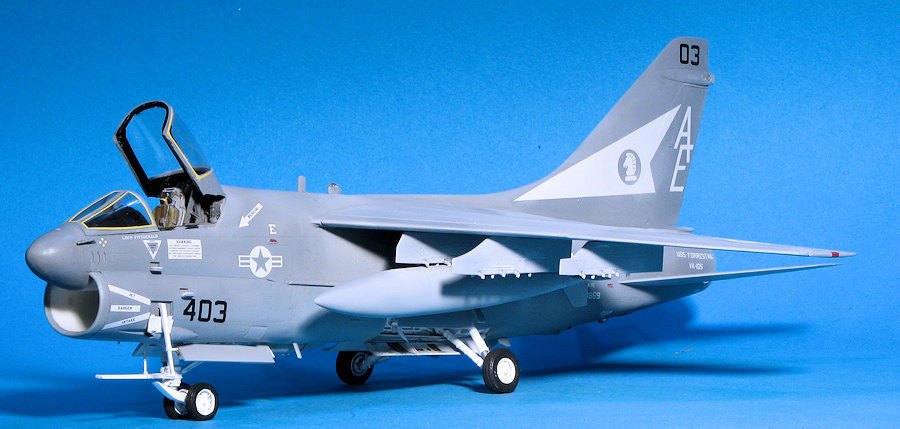
The Navy was sufficiently impressed with the increased power offered by the A-7D Spey engine used by the Air Force, and decided to use this engine for its own version of the Corsair II. The designation A-7E was assigned, and this version was to succeed the A-7B in production. However, there were delays in the deliveries of the TF41-A-2 engine specified for the A-7E, so the first 67 aircraft of the order were delivered with the TF30-P-5 engine. These aircraft had all of the other improvements planned for the A-7E, including the improved avionics and the M61 rotary cannon, and were re-designated A-7C after delivery.
 The first Spey-powered A-7E flew for the first time on 9 March 1969. The A-7E differed from the USAF A-7D in retaining the probe-and-drogue midair refueling system of the earlier A-7A/B. It entered service in Southeast Asia in May 1970 with VA-146 and VA-147 deployed aboard the USS America. The A-7E participated in numerous close-air support missions over both North and South Vietnam, the A-7E's state-of-the-art bombing and navigation system being particularly reliable and accurate. Most air wings operating Douglas A-4 Skyhawks and early A-7s were re-equipped with A-7Es. The A-7E participated in the mining of Haiphong harbor in 1972, and played a vital role in Operations Linebacker I and Linebacker II that led up to the formal end of US involvement in the Vietnam War on 24 January 1973.
The first Spey-powered A-7E flew for the first time on 9 March 1969. The A-7E differed from the USAF A-7D in retaining the probe-and-drogue midair refueling system of the earlier A-7A/B. It entered service in Southeast Asia in May 1970 with VA-146 and VA-147 deployed aboard the USS America. The A-7E participated in numerous close-air support missions over both North and South Vietnam, the A-7E's state-of-the-art bombing and navigation system being particularly reliable and accurate. Most air wings operating Douglas A-4 Skyhawks and early A-7s were re-equipped with A-7Es. The A-7E participated in the mining of Haiphong harbor in 1972, and played a vital role in Operations Linebacker I and Linebacker II that led up to the formal end of US involvement in the Vietnam War on 24 January 1973.
On 15 May 1975, A-7E aircraft operating from the USS Coral Sea, in conjunction with A-7D aircraft assigned to the 3d TFS at Korat RTAFB, provided air cover in what is considered the last battle of the Vietnam war, the recovery of the SS MayagŁez after it was hijacked by Khmer Rouge gunboats. By the time the Mayaguez incident was over, three USAF Sikorsky CH-53 Sea Stallion helicopters had been shot down, two airmen, 11 Marines and two Navy Corpsmen had been killed in action and a further three Marines were missing in action.
U.S. Navy A-7 Corsairs began being phased out of the fleet during the mid-1980s with the arrival of the McDonnell Douglas F/A-18 Hornet. Naval Reserve A-7 squadrons transitioned concurrent with (but prior to the completion of) all Regular Navy squadrons. The last Navy A-7s were retired by the last fleet operational squadrons (VA-46 and VA-72) in May 1991 shortly after their return from Operation Desert Storm. By the end of 1998, with the exception of some airframes used as static displays, all U.S. A-7s were disposed of to the AMARC at Davis-Monthan AFB, Arizona.
Some of these surplus aircraft were passed to Greece, Thailand and Portugal. The last Portuguese A-7Ps were retired in 2007 after 26 years. Greece retired its A-7s in 2014. The Corsair II served for 49 years.
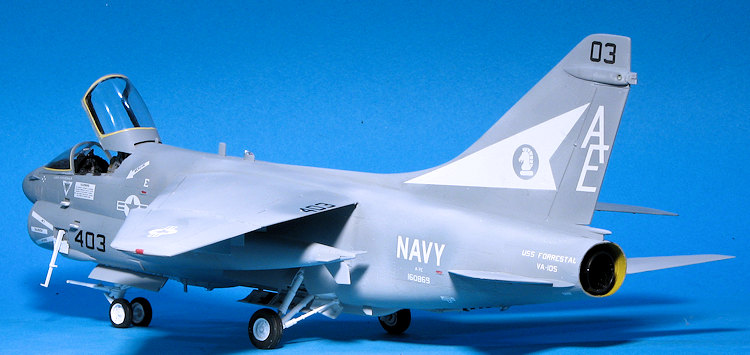 Hasegawa's A-7 series was initially released in 1987 and is still what many consider to be the best A-7 in this scale. The kit has been previewed several times, but not this particular boxing. The kit is currently released in its basic boxing as both an A-7D and A-7E, apparently included both sets of sprues as there are bits different between the two versions.
Hasegawa's A-7 series was initially released in 1987 and is still what many consider to be the best A-7 in this scale. The kit has been previewed several times, but not this particular boxing. The kit is currently released in its basic boxing as both an A-7D and A-7E, apparently included both sets of sprues as there are bits different between the two versions.
However, that is now and this kit is then when the D and E kits were boxed separately. The kit includes a fairly nice interior with an 8 piece bang seat. The seat is without harness detail as one is expected to install the pilot figure that is included. The kit provides two different seats actually and since the base instructions are for the initial boxing, you'll have to figure out which is appropriate for planes offered in this edition. Back to the cockpit there is a tub with separate side consoles a set of rudder pedals, a control stick and the appropriate instrument panel for the E version.
One will need to open several holes in the fuselage prior to installation of the cockpit and tail assembly. There is also a rather complete intake provided which contains the nose gear well. There will be a rather long seam that will be difficult to hide, though there have been aftermarket single cast intakes produced for this kit. A rather odd inclusion is a separate speed brake, which can be modeled deployed. Frankly, I've never seen this down on the ground as it is quite long. Those that build kits in flight would be the ones to take advantage of this feature.
Another feature are molded in avionics bays with their separate doors. One of these doors is for the RAT (ram air turbine). While having these doors open seems to be a rather regular occurrence in the USAF, one rarely saw this done in the Navy where issues of salt air are a concern. Cutting away the door hinges will allow those to be closed.
The kits wings are molded with a number of features. One is that you canbuild the kit with the wings folded. Those who like folded wing models and who also may want a bit more shelf space will like this feature. Another is that the flaps and slats can be modeled deployed. Again, this was not often seen on the ground, but the option is there and I know many who will appreciate this.
is that the flaps and slats can be modeled deployed. Again, this was not often seen on the ground, but the option is there and I know many who will appreciate this.
Landing gearis well done and the kit seems to have the proper USN wheels. Something different from the USAF variant is the launch bar and its piston. Before assembling the wings, one needs to open the holes for the pylons. I have to tell you that it was quite normal for all six to be attached to the plane, even if it wasn't carrying anything. For stuff to hang on the plane you have a pair of fuselage Sidewinders (again, these were something rarely carried), a pair of fuel tanks, a pair of MERs (Multiple Ejection Racks) and the large FLIR (Forward looking infrared) pod. I found it interesting that the instructions would have you mount the large fuel tanks on the outer pylons. I'm not sure if those were even plumbed for fuel, but these were usually carried on the inboard pylons. If you want bombs and such, you'll have to get one of Hasegawa's weapons sets. Fortunately, the pylons include the anti-sway braces. I should also mention that there are a pair of photo-etch backings for the external cable runs.
Instructions are typical Hasegawa with Gunze paint references. Markings are for one of the two final USN A-7Esquadrons that participated in Desert Storm, VA-72. One is the squadron commander's plane with some color in the tail and that is the one shown on the box art. The other is the specially painted 'Desert Storm' plane that was tricked out after the war in two browns. The decal sheet contains the fuselage and tailplane walk areas as well as lots of stencils. They are also old school Hasegawa decals where the whites are more of an ivory and they are a bit thick. Fortunately, there is no lack of A-7E decals in this scale.
My first task was to prep the fuselage. Though it usually means a huge delay in getting the kit built, and sometimes the kit will sit for years because of it, I decided to use a Black Box resin cockpit (48030) and a Cutting Edge replacement intake that I've had for years. I realize both companies are out of business, but similar items can still be found from other aftermarket makers.
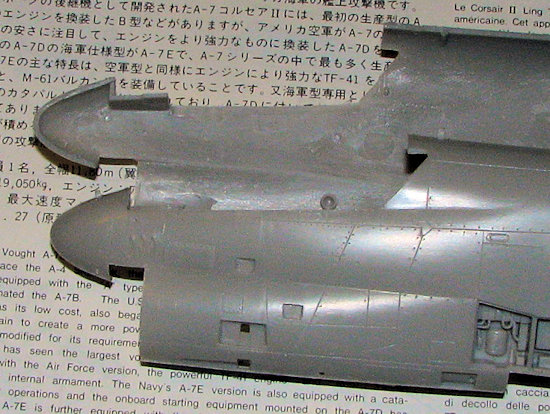 The intake required the forward section of the kit fuselage at the intake to be trimmed back. This also removes a pair of small antennas and replacements are not included in the intake set. For the interior, I had to remove the inside wall detail and the sills had to be trimmed back. That was done and I turned to the resin bits.
The intake required the forward section of the kit fuselage at the intake to be trimmed back. This also removes a pair of small antennas and replacements are not included in the intake set. For the interior, I had to remove the inside wall detail and the sills had to be trimmed back. That was done and I turned to the resin bits.
The Cutting Edge intake is the easiest of the two so I started work on that. For this, I sanded the molding blocks from the back of the intake compressor face and cut the nose gear well away from its stub as well. The compressor face was painted dark aluminum and cemented to the back of the intake trunk. The nose gear well was also attached to the intake trunk and later painted white. I used the BLAP Super Sanding Blocks to square things away. I am finding these to be quite handy to have around.
Next, I gave all the cockpit bits a good coat of Tamiya superfine grey primer. I had thought about not painting the interior dark gull grey, but the primer is actually quite a bit lighter so all but the seat got a coat of that. Painting and assembling the cockpit is time consuming. I like that you get an extra upper control stick and throttle piece, but that is just because on that sprue are a single rudder pedal and a single mount for the gun sight glass. BTW, I broke one of the mount pieces cleaning it up so take care.
The upper consoles, instrument panel and upper interior side pieces were painted black. I used another shade of grey for a few items to give it a bit of contrast, and this included several of the radio knobs. Then all was dry brushed with white. Some bits had more white applied, such as the circuit breakers and throttle handle. A few items got some red and green just to spice things up, but jet cockpits are mostly black and grey unless the 'lamp test' button is pushed.
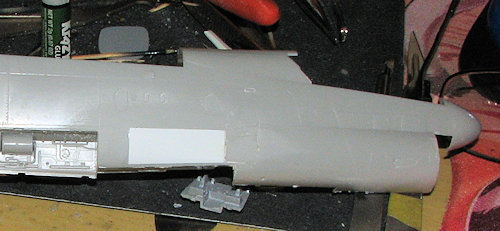 During all this, I went ahead and, after a bit of trimming to remove the hinges, installed the fuselage avionics bay doors closed. I ran into a bit of a problem when I could not find one of them so ended up having to make a new one out of plastic card. I deliberately chose card that was a bit thicker than needed as the door curves slightly on the lower section and this would allow me to sand in that curve. While doing this I also noticed quite a few sink areas on various kit pieces. Guess that when a mold is used as much as this, sink areas and flash are to be expected. I then set about filling in those sink areas.
During all this, I went ahead and, after a bit of trimming to remove the hinges, installed the fuselage avionics bay doors closed. I ran into a bit of a problem when I could not find one of them so ended up having to make a new one out of plastic card. I deliberately chose card that was a bit thicker than needed as the door curves slightly on the lower section and this would allow me to sand in that curve. While doing this I also noticed quite a few sink areas on various kit pieces. Guess that when a mold is used as much as this, sink areas and flash are to be expected. I then set about filling in those sink areas.
I then went to work installing the intake. I'd like to say it was a drop fit, but it was not. After trimming a bit more around the nose, I put it in place on one fuselage half and then, without gluing it on, put in the nose gear well. This allowed me to slide it around a bit to get it properly seated. This was all attached to that half and left to dry. Care taken in this area will provide a reasonably good fit, though filler and shaping will be required. I did a LOT of test fitting for this.
Once this was in fairly well, I installed the cockpit. Well, I tried to install the cockpit. The depressions in the resin intake were meant for the kit cockpit. I ended up cutting a chunk out of the lower rear of the tub where the resin is good and thick before getting it to fit. I then glued the fuselage halves together while fussing with the cockpit to get it in the proper place. During this I snapped off one of the seat rails and broke the control stick in half. Fortunately, the rail can be reattached and I have the kit control column to put in later. I left out the side panels as fitting showed they could be slid in later.
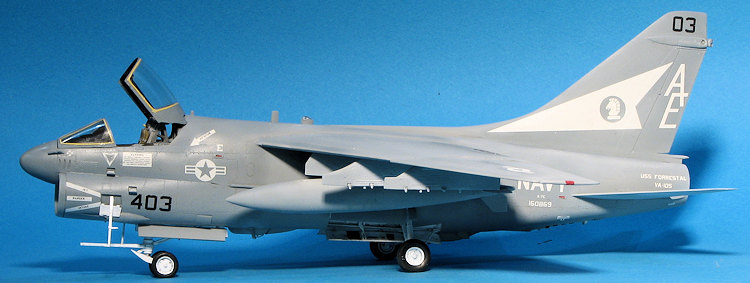
Then began a long period of filling and sanding. Meanwhile, I built up the wing sections, remembering to open the holes for the pylons in the process. I also realized that I'd forgotten to open any of the side fuselage holes for the ducting or the refueling probe. Finding the holes for the ducting was pretty easy as the plastic showed the deformation on the outside pretty easily. One of my ducts had been torn away from the sprue during its lifetime and so there is a bit of a divot in it. Installing these atop their p.e. base was not easy. I then attached the upper wing, breaking the canopy piston piece in the process. Fit here is not very good. The leading edge of the upper wing piece has more square edges to it than a smooth curve. More sanding and filling ensued.
I assembled all the slat pieces and cleaned them up along with the flaps. Looking through a LOT of photos of A-7Es on the ground, it seems that only about 5% of them showed the plane with slats and/or flaps extended. Most of the time these were raised so I assembled mine in this position. I then attached all sorts of little bits and pieces on the airframe other than those I thought would be easily knocked off.
With all that cleared up, I decided to paint it. I taped over the cockpit and painted the upper surface bits with FS 36320 and the underside bits with FS 36375 using Model Master enamels. The two shades are very close and difficult to tell apart most of the time, but that's low-viz for you. All the pylons , wing tanks, stabs, gear doors and such were painted at this time as well. I wrapped some tape to the insi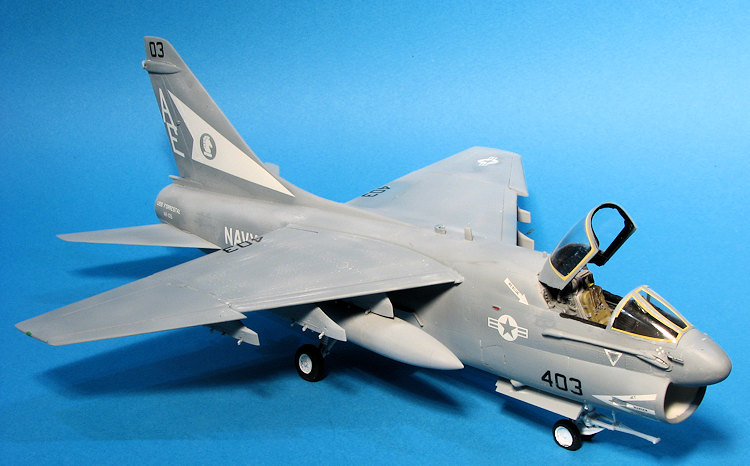 de of the intake a short ways down as the outer color wraps into the intake. This was not as difficult as I initially thought. The area behind the tape was filled with tissue.
de of the intake a short ways down as the outer color wraps into the intake. This was not as difficult as I initially thought. The area behind the tape was filled with tissue.
Once all that was done, I removed the Silly Putty masking from the wheel wells and glued in the landing gear. I didn't find out until later that I'd glued in the nose gear a bit crooked so pay attention. To be honest, I did not find any of the gear easy to install. I then attached the resin wheels. For this I used Royal Resin's set R028. Once those were affixed, the airframe got a gloss coat in preparation for decals. I had wanted to do a scheme from AirDoc 48014 which was all Pacific Fleet units. but when it got time to apply them, I couldn't find the instructions. I searched for several days and even put a plea on the web site's forum, but to no avail. Fortunately, I had set 48013 for Atlantic Fleet units and after about three or four weeks, used those decals. I picked a nice scheme from VA-105. After I put on the very last decal, I found the original instructions!
For me, applying decals is a slow process, and while that was going on, I built up each of the wing pylons by adding the small anti-sway braces. As a note, these are cast pieces so will have a seam on them, so do not feel you need to sand away the one on the parts. I also glued the wing tanks to the inner pylons at this time.
Next step for me was to attach the gear doors and most of the other small airframe pieces. This included the tail hook. There is no stripe decal provided on either sheet so I used Microscale stripes for this. The gear doors were maddening to attach as they just did not want to fit properly. As with much of this kit, these fought me every inch of the way. This was particularly true with the lower main gear doors and the catapult bar assembly.
 The interior was repaired with the broken bits replaced and the seat installed. I don't think I got the seat down far enough, but since the canopy will be open, this can simply be in the raised position. The boarding steps and ladder were attached as were the pitot tubes. I masked the windscreen and canopy with Furball Aero-Detail's 48-021, which is designed for this kit. I'd forgotten about this and had not used the wheel masks, though I did save them for a future project.
The interior was repaired with the broken bits replaced and the seat installed. I don't think I got the seat down far enough, but since the canopy will be open, this can simply be in the raised position. The boarding steps and ladder were attached as were the pitot tubes. I masked the windscreen and canopy with Furball Aero-Detail's 48-021, which is designed for this kit. I'd forgotten about this and had not used the wheel masks, though I did save them for a future project.
The masks worked fairly well and stick like limpets. However, I neglected to properly burnish them down and had leakage that was a bit of a mess to clean up. Before removing the masks, the windscreen was glued in place. For the canopy, I had to remove about half of the inside rear section before this would fit behind the seat. The seat rail braces are the main culprit for the lack of fit. I also drilled out the broken piston area so I could put in a piece of wire to replace it. The pylons were glued on as well as the tailplanes and the airframe got a coat of clear matte.
The last things I did were to attach the canopy, some clear bits, do a bit of touchup and then be very thankful that I got through this one.
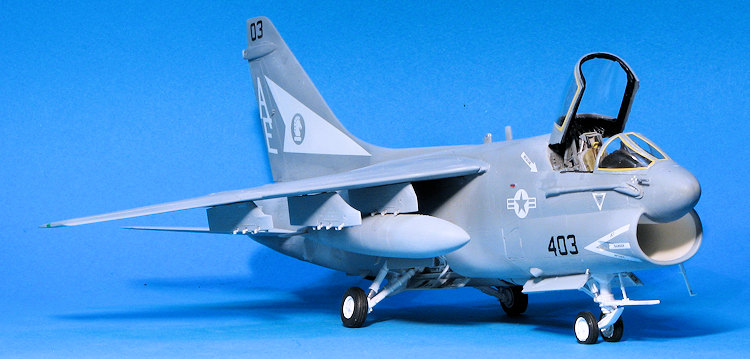 Because Hobby Boss boneheaded the intake and windscreen on their much newer A-7 kits in this scale (probably due to copying the inaccurate Monogram A-7A which was a worked over Aurora kit), the Hasegawa series of A-7D/E kits is still the best one out there in terms of shape though probably not in terms of ease of construction. It is not difficult to find, but I have to honestly tell you that the entire build was, for me, quite a trial. The kit does not want to be built with the wings extended or any of the panels closed, which is why you see so many built with everything open and the wings folded. I have a couple of these still in the stash and the next one I do will be built in this manner. This one fought me all the way and even though the end result is pleasing enough, was a lot of effort and a kit in which I made many mistakes. I'm going to blame aftermarket bits for some of these problems as it seems every time I build a kit with a lot of aftermarket, it turns into a major challenge to keep it from the shelf of doom.
Because Hobby Boss boneheaded the intake and windscreen on their much newer A-7 kits in this scale (probably due to copying the inaccurate Monogram A-7A which was a worked over Aurora kit), the Hasegawa series of A-7D/E kits is still the best one out there in terms of shape though probably not in terms of ease of construction. It is not difficult to find, but I have to honestly tell you that the entire build was, for me, quite a trial. The kit does not want to be built with the wings extended or any of the panels closed, which is why you see so many built with everything open and the wings folded. I have a couple of these still in the stash and the next one I do will be built in this manner. This one fought me all the way and even though the end result is pleasing enough, was a lot of effort and a kit in which I made many mistakes. I'm going to blame aftermarket bits for some of these problems as it seems every time I build a kit with a lot of aftermarket, it turns into a major challenge to keep it from the shelf of doom.
https://en.wikipedia.org/wiki/LTV_A-7_Corsair_II
3 June 2016
Copyright ModelingMadness.com If you would like your product reviewed fairly and fairly quickly, please contact the editor or see other details in the Note toContributors.
Back to the Main Page
Back to the Review Index Page
Back to the Previews Index Page


 The first Spey-powered A-7E flew for the first time on 9 March 1969. The A-7E differed from the USAF A-7D in retaining the probe-and-drogue midair refueling system of the earlier A-7A/B. It entered service in Southeast Asia in May 1970 with VA-146 and VA-147 deployed aboard the USS America. The A-7E participated in numerous close-air support missions over both North and South Vietnam, the A-7E's state-of-the-art bombing and navigation system being particularly reliable and accurate. Most air wings operating Douglas A-4 Skyhawks and early A-7s were re-equipped with A-7Es. The A-7E participated in the mining of Haiphong harbor in 1972, and played a vital role in Operations Linebacker I and Linebacker II that led up to the formal end of US involvement in the Vietnam War on 24 January 1973.
The first Spey-powered A-7E flew for the first time on 9 March 1969. The A-7E differed from the USAF A-7D in retaining the probe-and-drogue midair refueling system of the earlier A-7A/B. It entered service in Southeast Asia in May 1970 with VA-146 and VA-147 deployed aboard the USS America. The A-7E participated in numerous close-air support missions over both North and South Vietnam, the A-7E's state-of-the-art bombing and navigation system being particularly reliable and accurate. Most air wings operating Douglas A-4 Skyhawks and early A-7s were re-equipped with A-7Es. The A-7E participated in the mining of Haiphong harbor in 1972, and played a vital role in Operations Linebacker I and Linebacker II that led up to the formal end of US involvement in the Vietnam War on 24 January 1973.

 The intake required the forward section of the kit fuselage at the intake to be trimmed back. This also removes a pair of small antennas and replacements are not included in the intake set. For the interior, I had to remove the inside wall detail and the sills had to be trimmed back. That was done and I turned to the resin bits.
The intake required the forward section of the kit fuselage at the intake to be trimmed back. This also removes a pair of small antennas and replacements are not included in the intake set. For the interior, I had to remove the inside wall detail and the sills had to be trimmed back. That was done and I turned to the resin bits.  During all this, I went ahead and, after a bit of trimming to remove the hinges, installed the fuselage avionics bay doors closed. I ran into a bit of a problem when I could not find one of them so ended up having to make a new one out of plastic card. I deliberately chose card that was a bit thicker than needed as the door curves slightly on the lower section and this would allow me to sand in that curve. While doing this I also noticed quite a few sink areas on various kit pieces. Guess that when a mold is used as much as this, sink areas and flash are to be expected. I then set about filling in those sink areas.
During all this, I went ahead and, after a bit of trimming to remove the hinges, installed the fuselage avionics bay doors closed. I ran into a bit of a problem when I could not find one of them so ended up having to make a new one out of plastic card. I deliberately chose card that was a bit thicker than needed as the door curves slightly on the lower section and this would allow me to sand in that curve. While doing this I also noticed quite a few sink areas on various kit pieces. Guess that when a mold is used as much as this, sink areas and flash are to be expected. I then set about filling in those sink areas. 
 de of the intake a short ways down as the outer color wraps into the intake. This was not as difficult as I initially thought. The area behind the tape was filled with tissue.
de of the intake a short ways down as the outer color wraps into the intake. This was not as difficult as I initially thought. The area behind the tape was filled with tissue.  The interior was repaired with the broken bits replaced and the seat installed. I don't think I got the seat down far enough, but since the canopy will be open, this can simply be in the raised position. The boarding steps and ladder were attached as were the pitot tubes. I masked the windscreen and canopy with Furball Aero-Detail's 48-021, which is designed for this kit. I'd forgotten about this and had not used the wheel masks, though I did save them for a future project.
The interior was repaired with the broken bits replaced and the seat installed. I don't think I got the seat down far enough, but since the canopy will be open, this can simply be in the raised position. The boarding steps and ladder were attached as were the pitot tubes. I masked the windscreen and canopy with Furball Aero-Detail's 48-021, which is designed for this kit. I'd forgotten about this and had not used the wheel masks, though I did save them for a future project.  Because Hobby Boss boneheaded the intake and windscreen on their much newer A-7 kits in this scale (probably due to copying the inaccurate Monogram A-7A which was a worked over Aurora kit), the Hasegawa series of A-7D/E kits is still the best one out there in terms of shape though probably not in terms of ease of construction. It is not difficult to find, but I have to honestly tell you that the entire build was, for me, quite a trial. The kit does not want to be built with the wings extended or any of the panels closed, which is why you see so many built with everything open and the wings folded. I have a couple of these still in the stash and the next one I do will be built in this manner. This one fought me all the way and even though the end result is pleasing enough, was a lot of effort and a kit in which I made many mistakes. I'm going to blame aftermarket bits for some of these problems as it seems every time I build a kit with a lot of aftermarket, it turns into a major challenge to keep it from the shelf of doom.
Because Hobby Boss boneheaded the intake and windscreen on their much newer A-7 kits in this scale (probably due to copying the inaccurate Monogram A-7A which was a worked over Aurora kit), the Hasegawa series of A-7D/E kits is still the best one out there in terms of shape though probably not in terms of ease of construction. It is not difficult to find, but I have to honestly tell you that the entire build was, for me, quite a trial. The kit does not want to be built with the wings extended or any of the panels closed, which is why you see so many built with everything open and the wings folded. I have a couple of these still in the stash and the next one I do will be built in this manner. This one fought me all the way and even though the end result is pleasing enough, was a lot of effort and a kit in which I made many mistakes. I'm going to blame aftermarket bits for some of these problems as it seems every time I build a kit with a lot of aftermarket, it turns into a major challenge to keep it from the shelf of doom.